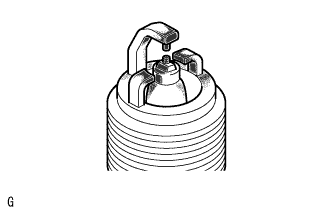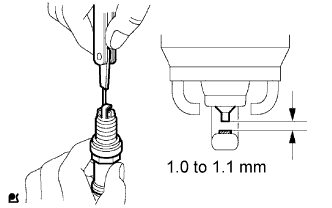Lexus IS250 IS220d GSE20 ALE20 4GR-FSE IGNITION
IGNITION SYSTEM - ON-VEHICLE INSPECTION
- NOTICE:
- In this section, the terms "cold" and "hot" refer to the temperature of the coils. "Cold" means approximately -10 to 50°C (50 to 122°F). "Hot" means approximately 50 to 100°C (122 to 212°F).
| 1. SPARK PLUG |
Check for DTCs.
- NOTICE:
- If any DTC is present, perform troubleshooting procedures for that DTC.
Check if sparks occur.
Remove the ignition coils.
Remove the spark plugs.
Install the spark plug to the ignition coil and connect the ignition coil connector.
Disconnect the 6 injector connectors.
Ground the spark plug.
Visually check that sparks occur while the engine is being cranked.
- NOTICE:
Perform the spark test according to the procedures below:
Check that the wire harness side connector of ignition coil with igniter is securely connected.
- Result:
Result Proceed to NG Connect securely OK Go to next step
Perform a spark test on each ignition coil with igniter.
- Result:
Result Proceed to OK Replace ignition coil with igniter NG Go to next step
Check the power supply to the ignition coil with igniter.
- Result:
Result Proceed to NG Check wiring between engine switch and ignition coil with igniter OK Go to next step
Check the VVT sensor output voltage.
- Result:
Result Proceed to NG Check that there is resistance between ECM and VVT sensor. If there is no resistance, replace VVT sensor. If there is resistance, repair wiring between VVT sensor and ECM. OK Go to next step
Check the resistance of the crankshaft position sensor.
- Standard resistance:
Temperature Specified Condition Cold 1,630 to 2,740 Ω Hot 2,065 to 3,225 Ω
- Result:
Result Proceed to NG Replace crankshaft position sensor OK Go to next step
Check the IGT signal from the ECM.
- Result:
Result Proceed to NG Check ECM OK Repair wiring between ignition coil and ECM
Using a 16 mm (0.63 in.) plug wrench, install the spark plug.
- Torque:
- 25 N*m{ 254 kgf*cm, 18 ft.*lbf}
Install the ignition coils.
| 2. INSPECT SPARK PLUG |
- NOTICE:

Check the electrode.
Using a megohmmeter, measure the insulation resistance.
- Insulation resistance:
- 10 MΩ or more
- HINT:
- If a megohmmeter is not available, perform the following simple inspection instead.

Alternative inspection method:
Quickly accelerate the engine to 4,000 rpm 5 times.
Remove the spark plug.
Visually check the spark plug.
If the electrode is dry, the spark plug is functioning properly. If the electrode is damp, proceed to the next step.
Check the spark plug for any damage to its threads and insulator.
- HINT:
- If there is any damage, replace the spark plug. If not, reinstall the spark plug.
- Recommended spark plug:
Manufacturer Product DENSO made FK20HBR11

Check the spark plug electrode gap.
- Maximum electrode gap for a used spark plug:
- 1.3 mm (0.051 in.)
If the gap is greater than the maximum, replace the spark plug.
- Electrode gap for a new spark plug:
- 1.0 to 1.1 mm (0.039 to 0.043 in.)
- NOTICE:
- If adjusting the gap of a new spark plug, bend only the base of the ground electrode. Do not touch the tip. Never attempt to adjust the gap of a used plug.